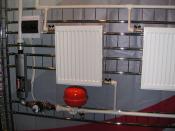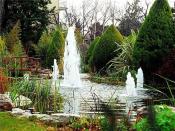Search
Login
Planting and growing grapes
The grapevine is both an ornamental and fruit bearing plant. The technology of growing grapes is a set of rules and precise actions that determine the success of viticulture. For beginning gardeners, we have prepared an article-guide, which outlines the process of growing grapes in stages - from planting to ripening berries.
Content
- Where to plant
- Planting grape seedlings video
- Pruning video
- Watering
- Grape fertilizer
- Grape diseases video
Where to plant
The grape needs direct sunlight and a sheltered area. Planting shrubs along the fence from the south or west side is welcomed; the surface of the fence warmed during the day will warm the vine, accelerating ripening of berries and neutralizing the effect of spring frosts to -5С. For northern areas where conditions are more difficult, early varieties resistant to low temperatures should be selected correctly.
Grapes do not have any special requirements for soil and easily adapt to the environment in which it grows, but the best option is a plot with a pond nearby and soil with a pH of 6.5 - 7.1. Another requirement for planting is the distance of the grapes from other plants: 2-3 meters from trees, 1.5 from bushes, 60 cm from the walls of buildings, 20-30 cm from the fence.
Planting grape seedlings
Natural organic fertilizers contribute to the good growth of the vine, therefore, before planting, manure is applied in a dose of 5-7 kg / m2 or compost about 10 kg / m2. Before planting, make a plan of the vineyard (if the planting is not for a pergola, arbor or fence), taking into account the distance between the seedlings and rows.
When planting in rows, the distance between them should be 1.5-2 m, between the bushes 0.8-1.2 m. Define the boundary lines of the vineyard, it can be rectangular or square. After marking two adjacent sides of the plot, straight lines of the rows with pegs or sticks are marked, this can be limited to in the first two years. In the future, it will be necessary to install a fence or posts with a height of at least 180 cm with an extended wire to support the vineyard.
Shrub planting begins in the fall (October) or spring. Planting grapes in autumn with seedlings is less time-consuming, since it does not require watering. Grape cultivation from cuttings and their planting are possible from April to the end of October. In prepared soil, pits with dimensions of 30x30 are made, abundantly watered and planted stalks.
If the soil has not been previously fertilized, the depth of the pit is increased to 60 cm and half of it is filled with organic fertilizer. Cuttings planted in autumn are covered with a layer of soil about 25 cm; in spring, the embankment is removed. Grafted seedlings are planted as described above. The vaccination site should be at a level of 3 cm from the ground.
The cultivation of grapes in the middle zone of Russia differs in planting time and the right choice of healthy seedlings and varieties. Grapes are planted in the fall, in September. The best frost-resistant varieties for the middle band are Kishmish 342, Laura, Summer Muscat, Krasa Nikopol, Anniversary of Novocherkassk.
Pruning
Pruning the vine determines the size and quality of the crop. During the growing season, grapes require 4-5 pruning procedures. A shrub without proper pruning degenerates and ceases to bear fruit. Pruning in winter is from November to February, spring pruning in May, summer from June to August.
Saplings planted last fall cut, leaving only two of the strongest shoots. In the second year, leave branches with only a minimum diameter of 6 mm and cut them to 70 cm in height. In the third year, the branches have a height of up to 3 meters, horizontal branches with processes have already been formed and no more than 4-6 processes are left during pruning. Clipped and dried, damaged by the disease leaves, weak processes and stepsons, leaves obscuring the fruit.
Watering
Lack of moisture at the beginning of the growing season is possible on sandy soil. In the case of clay soil, moderate watering is used, as grapes do not like excess water. At a depth of 15-20 cm, the soil should be moist, if it is loose - we water the plant, sticky and easily compresses into a lump - we stop watering.
A prolonged excess of moisture inhibits the growth of shrubs, in extreme cases, young leaves and tops of branches turn yellow and dry. Drainage and frequent loosening of the soil will help moisture evaporate faster. During flowering, grapes need hot and dry weather, watering at this time is only welcome in case of prolonged drought.
Grape fertilizer
If the soil was fertilized to the base of the vineyard, the first two years there is no need to update microelements. For the third year, in the fall, it is advisable to conduct a chemical analysis of the soil and do it every 2-3 years. Excess or lack of elements leads to crop loss and disease.
Nitrogen, one of the most important trace elements for grapes, is indicated by its slow growth, small and early falling leaves, and fruits ripen later. An excess of nitrogen is manifested by fungal diseases, increased growth of branches during the winter period, its high content limits the absorption of potassium by the roots. The nitrogen content in compost is 20%, slurry is 30%.
Grapes growing on sandy soil are susceptible to potassium deficiency; frost resistance of a plant and productivity are significantly reduced with its lack. Potassium deficiency is manifested by symptoms of chlorosis on the leaves, the fruits ripen after the due date, their palatability deteriorates. Manure and litter are a rich source of easily digestible potassium.
Other important ingredients for successful grape growing are calcium, magnesium, iron, boron, manganese, copper, and molybdenum. Green fertilizers are very valuable for feeding grapes; in late spring, green manure such as blue and yellow lupins, oats, rape, tansy are sown. Lupine especially stood out among other fertilizers as an assistant in weed control.
Grape diseases
The most common grape disease is downy mildew. Symptoms of the disease are easy to notice on young leaves, yellow-brown spots appear, leaves turn yellow and fall off, rarely the disease forms on inflorescences and berries. The spores of the fungus winter on fallen leaves and are carried by the wind, infecting other plants.
Prevention, the best protection against false dew and other diseases. Clean dry and fallen leaves in time, burn infected away from grapes. Proper pruning, fertilizer application, weed removal help plants strengthen their immunity. Powdery mildew more often manifests itself at high temperature and humidity. The leaves of the grapes are covered with small pale green dots, in the future the leaves dry out. The disease develops rapidly at 25-30C, at the same time, at temperatures above 35C, the fungus dies, as during severe frosts.
Gray rot develops mainly on old leaves; these are large fluffy spots with a yellow border. Infected inflorescences dry up, the fruits do not ripen for a long time and rot quickly. Black and white rot is preceded by humid and warm weather (rains and 25C). The leaves are affected by red and brown spots, the fruits rot and dry. The fight against fungal diseases is based on spraying plants with fungicides before flowering and at the beginning of berry ripening.





